
Alannah Farrell: Hi Mehdi, thank you for taking the time to chat with me about your work. I was blown away by your show Parade Square, which opened last Thursday at Richard Taittinger Gallery on New York’s Lower East Side. 2018 was a busy year for you! What excited you most as a working artist this year?
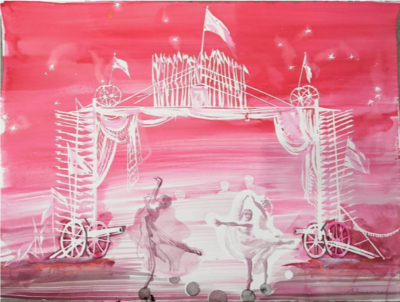
Mehdi Farhadian: I was excited about the acquisition of one of my works, Cannons and Ballerinas, by the British Museum this spring.
However, the rest of this year I was busy working on my exhibition and this is an everyday excitement full of motivation for me.
AF: I discovered your work through your 2016 solo show, Sanctums of Decision at Richard Taittinger Gallery. Within that show, I fell in love with the eerie and dreamlike Mid-Day Temptation. To this day it remains one of my favorite contemporary paintings. Can you tell me more about this piece, its history and meaning to you?
MF: Sanctums of Decision of politicians were the primary source of my idea for my last exhibition and I tried to create a magical atmosphere of the spaces where politicians decide for us people. These spaces might sometimes be a real space and other times I made an image of what this could look like.

In this specific work, I painted it from a politician’s perspective who is sitting behind his table and is looking at the Persian garden through the window of the palace. He sees a bunch of ghost-like creatures arranged in a crown shape that are posing gestures such as temptation, seduction, and threatening. This is a very theatrical view, and I shifted from my usual landscapes to an interior view.
AF: Parade Square seems like an elevation and a departure from your previous work. Unlike Sanctums of Decision, this show focuses on one location, the parade square. Why did you decide on this location as the jumping off point for your new body of work? Do you have personal historical ties to this place?

MF: Whenever I pass by the parade square (Meydan-e-Mashq) in the downtown of a crowded city of Tehran, I see it as an isolated location from the city with peace and calmness inside. This provoked my imagination to make my new series on such a world in which I build up my concepts.
“Parade Square” is a translation of “Meydan-e-Mashq”, which in Farsi means a scene for eternal efforts to stay equipped and prepared for an uncertain future. This concept is so close to the circumstances we face in our country right now, trying to always be prepared with no certain future.
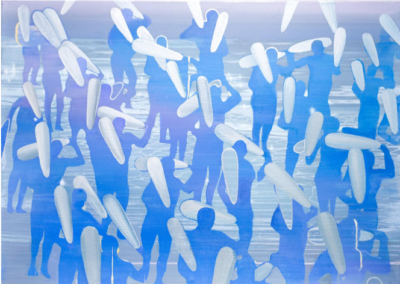
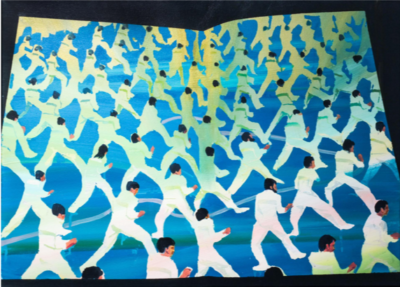
AF: Wow, that’s beautiful. And that feeling is something many Americans may be able to relate to as well.
The repetitive formations of people become pattern-like in Championship Workout, The Peace Girls, and The Youth of the Homeland. And you frame the latter two in a black negative space, which gives the interior images a shape like the open spread of a book. These works are both abstract and representational, very different from your past works. Can you tell me a little about your decision to shift towards a bold new graphicness?
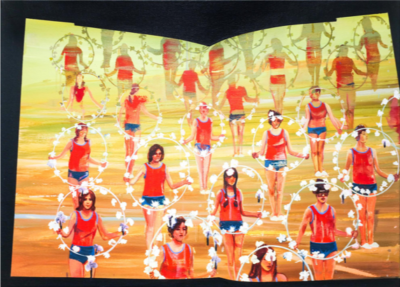
MF: This is a good question. I tried to focus on selecting the right pictures to shape a scenario for the whole exhibition, in contrast with my previous works where I shaped the scenario within each individual work. This was a new experience for me, and I selected these mentioned pictures from the pages of a book I photographed before.
Making the paintings abstract and graphic in book-shape has the aim to indicate that they are timeless and continuous.
AF: I love the elegant wryness in Technical Defect and Technical Defect 2. These both depict scenes of things going awry within architectural spaces. A deflated air balloon caught atop a majestic angular gold and white structure resonated with me as a New Yorker. Was this painting inspired by an event you witnessed?

MF: This painting wasn’t based on an actual event or an event I witnessed. I illustrated it myself. The painted building is Iran’s former Senate House, with two bronze columns outside symbolically linking the earth to the sky with a twisting chain.
AF: I was fortunate to meet you at the beginning of this year when you came to New York and spoke about your work at the gallery. You read some of your poetry along with that show which really helped me understand your work with more depth and context. Have you been writing this year?
MF: My focus for this year was mostly on reading and painting, I wrote very few poems. This is a more personal aspect of my life, not necessarily in direction with my paintings.
AF: You’ve shown your work at the 2015 Venice Biennale and now three times in New York City at Richard Taittinger Gallery. And your home city of Tehran inspires your work. How do you feel about showing your work outside Tehran? Do you feel foreigners will lose the work’s meaning or bring their own interpretations to it? I have never been to Tehran or Iran and thus feel I bring my own interpretations to your work. Yet your paintings resonate so strongly with me, even though I’m aware of myself not understanding the depth of historical and cultural references imbued within each of your works.
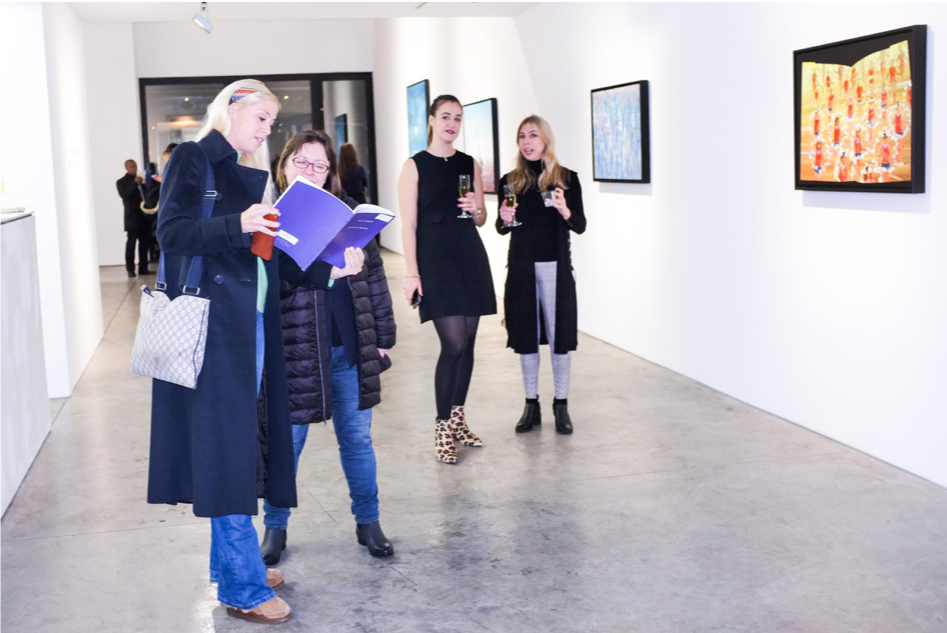
MF: As you know, contemporary art needs to be explained and you need to know many things about other cultures to get their concepts, and still, we don’t fully understand. For example, this year I referred to Soviet paintings and pictures I took from their museums before to get inspired by the colors and rhythms, because of similarities between my concepts and those paintings. However, I cannot have a hundred percent understanding of Soviet pictures and these are only my personal feelings. Thus, I don’t expect foreigners to fully understand my paintings, but the feedback I got from audiences outside Iran shows how open they are to interpreting other nations.

AF: You couldn’t attend the opening of your first solo show in the US, Sanctums of Decision in 2016, due to visa issues. Once again, visa issues prevented you from attending the opening of Parade Square which opened on November 15th, 2018. I’m so sorry that you couldn’t attend your opening last week. The American government is shamefully embarrassing at this point and negatively affecting lives all over the globe. I wish I could change it. What is your opinion about politics interfering with artists and their work?
MF: You understand how important it is for an artist to attend the opening of their exhibition personally. Besides all the positive energy I got from the exhibition, it made me feel exhausted at the end.
I think preventing artists, scientists and culturally important people from entering a country no matter where they are from, cannot prevent their ideas and impacts from reaching that country. In the global world of technology and social media, this is not a return to a glorious and great past. This will slow down the future.
AF: I completely agree. I’m grateful you and many artists have access to modes of communication and sharing such as Instagram, social media, and email. Not everyone or all countries have access to these. I wish the world valued artists, scientists, and ideas as much as they do money. In the spirit of looking forward, are you working on your next body of work?
MF: Yes, I’ve started working on my new series based on my dreams about my neighborhood. This is deeply related to my city and culture, so I decided to show it in Tehran and maybe in London as well.
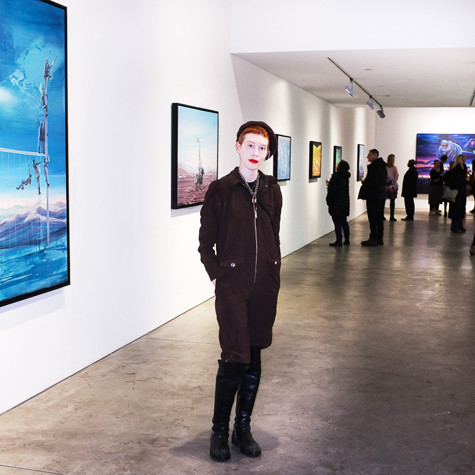
AF: Your tireless studio practice is inspiring! I am looking forward to hearing more about your newest work. Mehdi, Thank you so much for speaking with me. I encourage everyone to visit Parade Square, Mehdi Farhadian’s solo show at Richard Taittinger Gallery. On view until December 21st, 2018. Follow Mehdi on Instagram here.
